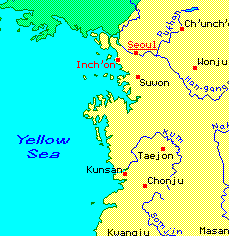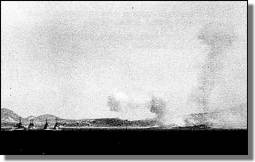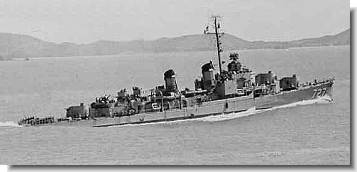You Can Thank Six Brave Ships for
Inchon Win
By Relman Morin off Inchon
 (AP) - The landing at Inchon, in
a large part, is the story of six brave little Ships and a wonderful blunder. (AP) - The landing at Inchon, in
a large part, is the story of six brave little Ships and a wonderful blunder.
The North Koreans made the blunder. The little ships, the big ones, the
planes and finally a Marine assault force capitalized on it.
A chain of events started by these six ships led directly to the victory of
Inchon.
In the entrance of Inchon harbor, and commanding approaches to it, is the
island of Wolmi. It is a wooded island shaped like an oyster shell. From the
beaches, the ground rises 300 feet to a rounded top, A stone causeway connects
the island to the Inchon waterfront.
Wolmi was the key to the entire operation. Before the main attack could
begin on Inchon, Wolmi had to be taken. In an order issued before the battle,
Rear Admiral James H. Doyle, commander of Task Force 90, said:, "This
mission (Wolmi) must be successfully completed at any cost. Failure will
seriously jeopardize or even prevent the major amphibious assault on Inchon
therefore, press the assault with the utmost vigor despite loss or
difficulty."
Big questions loomed. What did the north Koreans have on Wolmi to defend it?
How many guns? How big? Where?
 |
Five U.S. Navy destroyers steam up the
Inchon channel to bombard Wolmi-Do island on 13 September 1950, two days
prior to the Inchon landings. Wolmi-Do is in the right center background,
with smoke rising from air strikes. The ships are USS Mansfield (DD-728); USS DeHaven (DD-727); USS Lyman K. Swenson (DD-729); USS Collett (DD-730) and USS Gurke (DD-783). Click
on picture for larger view.
|
Six brave little ships. six destroyers, were sent to find out.
Vice Admiral Arthur D. Struble, commander of Joint Task Force 7, ordered a
"reconnaissance in force."
The mission frankly was to draw fire from Wolmi-the more the better.
A destroyer's armor is three-eighths of an inch thick. Practically anything
stronger than a slingshot will pierce it.
On the morning of September 13, "D-day minus two," the six brave
little ships, moving in column, and slowly, sailed into the narrowing channel
leading pass Wolmi to Inchon.
One anchored off of the southern face of the island. Three passed through
the neck of the channel to the other side. Two remained in the channel.
None was more than a mile from the beaches and some were 1,000 yards-two
thirds of a mile.
They were "sitting ducks." That's what they were meant to be,
juicy targets for concealed guns on the shore.
From all over the elbe of the channel farther down, thousands of binoculars
were trained on them from American and British cruisers. The silence was like a
blanket. It was a brilliant sunny day, and you could see even without
binoculars.
Suddenly there was a single white flash. Seconds later the muffled crack of
the gun came back. "The 730 reported she spotted a battery moving on the
beach," a report to the bridge of the flag ship said.
A few more tense, breathless, incredible seconds of waiting passed. Still
silence. Wolmi Island looked like a picnickers paradise, green-wooded and
serene.
Then the North Koreans made a fateful and wonderful blunder. Suddenly a
necklace of gun flashes sparkled around the waist of the island. The flashes
were reddish gold and they came so fast that soon the entire slope was
sparkling with pinpoint of fire.
The destroyers were quick to answer.
Lightening flashes leaped from their guns. They hit back, shell for shell,
firing faster and faster until the whole channel was a tunnel of rumbling
thunder.
The pace increased. On Wolmi, still more gun positions opened up. The red
necklace spread and widened. They were hitting destroyers now. They could
hardly miss at that range.
Then a report came down to the bridge and your blood ran cold. "It
looks as though the 783 is dead in the water, Sir." Admiral Struble's
answer was quiet and the words were taut. "Make sure and then see what we
have to do to get her out of there."
The duel went on for an hour. It was a slugging match, toe to toe, and
nobody quit or backed away. Six brave little ships sat there and shot it out
with the dug in enemy gun crews on Wolmi Island.
Three of the six were hit, one seriously, but not so seriously that she
could not come out under her own steam. An officer died. There were other
casualties.
 |
| The DeHaven makes a hasty retreat from Wolmi-Do.
Photo taken from the HMS Kenya. Contributed by Tony
Berry |
The destroyers came out proudly and without haste, still firing flat
trajectory fire at close range and then at higher arcs as the distance
increased.
The mission was accomplished successfully, the navy will say. Gloriously is
a better word.
If the guns on Wolmi Island had never been discovered; if the North Koreans
had not blundered into exposing their armament, it is hard to say what might
have happened to the transports and the little landing craft when they came in
for the assault two days later.
At best, the casualties would have been enormous -for Wolmi Island is
studded with guns-at worst, the invasion could have stalled right there at the
first objective.
Six brave little ships exposed themselves to fire. The bigger guns and
hordes of planes knocked it out before the Marines ever appeared.
Six brave little ships: the Mansfield DD728, DeHaven 727, Collett 730 Lyman
K Swenson 729, Gurke 783 and the Henderson 785.
More on the invasion at the Mansfield Page
Two days later the Marine invasion took place.
[ Up ] [ Six Brave Ships ] [ Eddie Snelling's Inchon Invasion Photos ] [ Gunnery Officer's View ] [ Bob Sauer Remembers ] [ 10 Enemy Vessels Approaching ] [ Enemy Vessels Approaching ] [ Land The Landing Force ] [ Assault on Red Beach ] [ Operation Chromite ] [ Shoot Us If You Can ] [ The Taking of Wolmi-do ]
> |

 (AP) - The landing at Inchon, in
a large part, is the story of six brave little Ships and a wonderful blunder.
(AP) - The landing at Inchon, in
a large part, is the story of six brave little Ships and a wonderful blunder. 